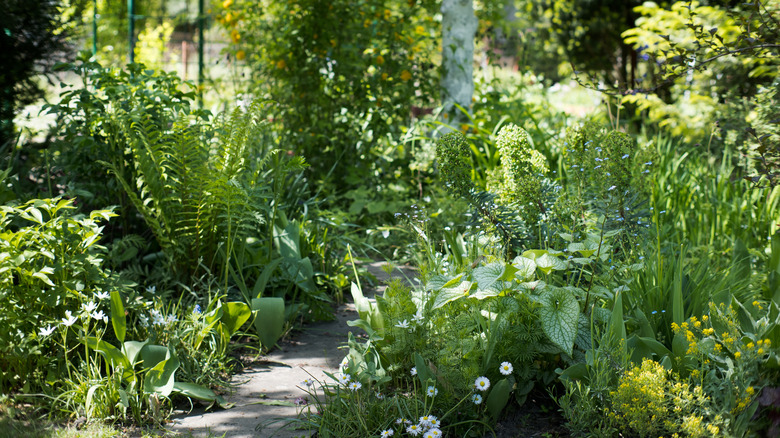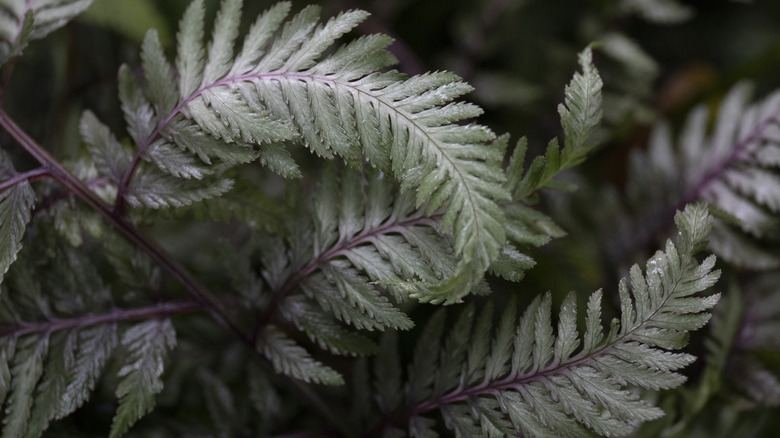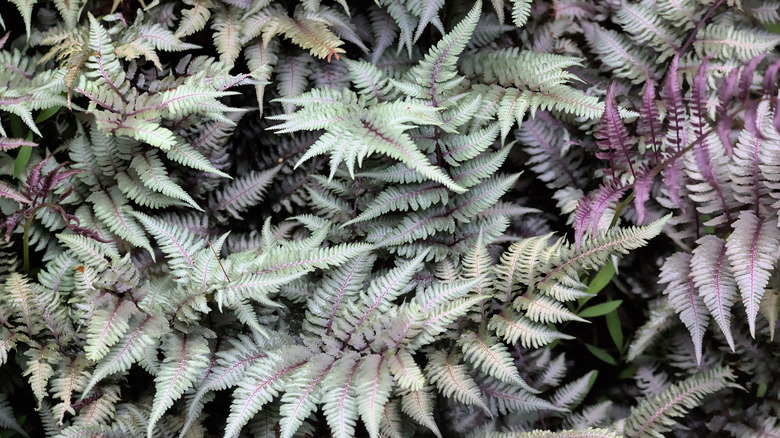Fill Your Shady Garden With Color With A Popular Easy-To-Grow Perennial
Is your yard starting to feel a bit blah because of all those dark, shady spots? It's common for areas without much sunlight to get swallowed up by plain, green textures, making the whole garden look a bit flat. Thankfully, you can grow a gorgeous, healthy shade garden using a plant that will brighten the gloomy corners: the Japanese painted fern (Athyrium niponicum). This easy-to-grow perennial isn't like other ferns. Its foliage catches the light and shimmers, making the plant appear as if it has been painted. It's an excellent low-effort way to turn a boring spot in the garden into a focal point.
Native to East Asia, including Japan and Korea, this plant has become a favorite for shade gardens across North America. The appeal of the Japanese painted fern lies in its shifting and blending colors. Instead of being one tone of green, its fronds have a soft, silvery-gray base, often tinted with blue. This pale color contrasts with the deep wine-red central veins. These metallic shades are very different from the green you usually see under trees and large shrubs. Its colors are at their peak when new fronds grow in the spring, and it stays looking great until it rests for the winter after the first hard frost.
Creating the ideal habitat
If you've struggled with keeping ferns happy in the past, you should know that Japanese painted ferns are easy to care for, provided their basic needs are met. This plant is cold-tolerant and thrives in a wide range of climates within USDA Hardiness Zones 3 through 9. While this plant needs shade, too much shade can dull the silvery-red markings, making the fronds look greener. The perfect location is one that gets light, dappled shade throughout the day or, if in the northern part of its growing zone, a few hours of gentle morning sun. Planting in areas that receive harsh afternoon sun is among the mistakes to avoid when using ferns as ground cover. Protecting Japanese painted ferns against direct sunlight is the best way to prevent the foliage from scorching or bleaching.
These ferns prefer organically rich soil that's consistently moist, but not soggy, to prevent the roots from suffocating or developing fungal issues. Adding compost to the area before planting will help the soil retain moisture while allowing excess water to drain away. If the fronds begin to turn yellow and wilt, it's usually a sign that they are getting too much water. However, if the edges turn brown, it means the soil is too dry. Once established, the Japanese painted fern can handle short, dry periods better than most other ferns, but keeping the soil moist will result in the plant looking its best.
Texture, size, and companion planting ideas
This plant grows slowly via creeping rhizomes, forming a clump, which makes it a good choice for planting in groups or as a decorative ground cover. It grows about 24 inches high and wide, allowing it to fill in the front of a garden bed without overpowering smaller perennials. It's a low-maintenance choice that rarely has any issues with pests or diseases, and it's also resistant to deer and rabbits.
When planting a Japanese painted fern, think about which companion plants will complement its features. Plants with broad leaves, such as hostas with blue or variegated foliage, pair well with the painted fern. Other excellent choices include plants that enjoy shady, moist areas, such as Astilbe, which features feathery plumes of color, and Brunnera varieties, like 'Jack Frost,' with mottled leaves that resemble the fern's color palette. Japanese painted ferns make an ideal companion plant for showing off gorgeous hydrangea blooms in the garden, while spring-flowering bleeding hearts (Dicentra spp.) and coral bells (Heuchera spp.) add some early-season color.


